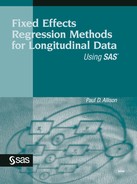1.6. What You Need to Know
To understand this book, how much you should already know depends on how far you want to go. To read chapter 2 on linear models, you need to be familiar with multiple linear regression. That means that you should know something about the assumptions of the linear regression model and about estimation of the model via ordinary least squares. Ideally, you should have a substantial amount of practical experience using multiple regression on real data and should feel comfortable interpreting the output from a regression analysis. As part of this knowledge, you must certainly know the basic principles of statistical inference: standard errors, confidence intervals, hypothesis tests, p-values, bias, efficiency, and so on.
To read chapter 3, you should have, in addition to the requirements for chapter 2, a knowledge of logistic regression at about the level of the first three chapters of my 1999 book Logistic Regression Using the SAS System: Theory and Application. That is, you should understand the basic model for binary logistic regression, how to estimate that model via maximum likelihood, and how to interpret the results in terms of odds ratios. Some familiarity with PROC LOGISTIC is helpful, but not essential.
For chapter 4 on fixed effects Poisson regression, you should have a basic familiarity with the Poisson regression model, discussed in chapter 9 of Logistic Regression Using the SAS System: Theory and Application. I'll use PROC GENMOD to estimate the model, so previous experience with this procedure will be helpful.
For chapter 5 on survival analysis, some basic knowledge of the Cox proportional hazards model and partial likelihood estimation is essential. These methods are described in my 1995 book Survival Analysis Using SAS: A Practical Guide, along with instruction on how to use the PHREG procedure.
Finally, to read chapter 6 you should have some knowledge of linear structural equation models (SEMs) that include both observed and latent variables. A good introduction to this topic for SAS users is A Step-by-Step Approach to Using the SAS System for Factor Analysis and Structural Equation Modeling (Hatcher 1994).
I have tried to keep the mathematics to a minimal level throughout the book. In particular, there is no calculus and little use of matrix notation. Nevertheless, to simplify the presentation of regression models, I frequently use the vector notation ![]() . While it would be helpful to have some knowledge of maximum likelihood estimation, it's hardly essential. With regard to SAS, the more experience you have with SAS/STAT and the SAS DATA step, the easier it will be to follow the presentation of SAS programs. On the other hand, most of the programs presented in this book are fairly simple and short, so don't be intimidated if you're just beginning to learn SAS.
. While it would be helpful to have some knowledge of maximum likelihood estimation, it's hardly essential. With regard to SAS, the more experience you have with SAS/STAT and the SAS DATA step, the easier it will be to follow the presentation of SAS programs. On the other hand, most of the programs presented in this book are fairly simple and short, so don't be intimidated if you're just beginning to learn SAS.
